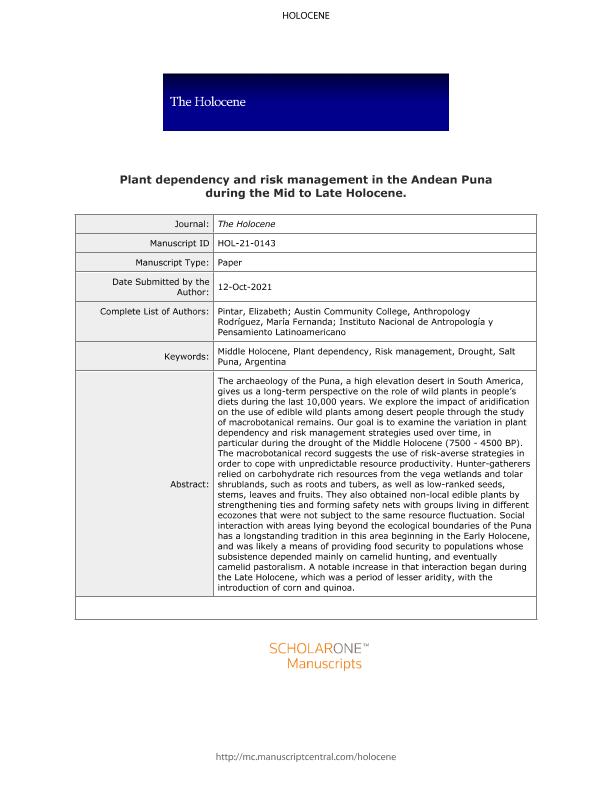Mostrar el registro sencillo del ítem
dc.contributor.author
Pintar, Elizabeth Lucia

dc.contributor.author
Rodríguez, María Fernanda

dc.date.available
2023-12-13T15:26:18Z
dc.date.issued
2023-06
dc.identifier.citation
Pintar, Elizabeth Lucia; Rodríguez, María Fernanda; Plant dependency and risk management in the Andean Puna during the Mid to Late Holocene; Sage Publications Ltd; The Holocene; 32; 12; 6-2023; 2-33
dc.identifier.uri
http://hdl.handle.net/11336/220166
dc.description.abstract
The archaeology of the Puna, a high elevation desert in South America,gives us a long-term perspective on the role of wild plants in people?sdiets during the last 10,000 years. We explore the impact of aridificationon the use of edible wild plants among desert people through the studyof macrobotanical remains. Our goal is to examine the variation in plantdependency and risk management strategies used over time, inparticular during the drought of the Middle Holocene (7500 - 4500 BP).The macrobotanical record suggests the use of risk-averse strategies inorder to cope with unpredictable resource productivity. Hunter-gatherersrelied on carbohydrate rich resources from the vega wetlands and tolarshrublands, such as roots and tubers, as well as low-ranked seeds,stems, leaves and fruits. They also obtained non-local edible plants bystrengthening ties and forming safety nets with groups living in differentecozones that were not subject to the same resource fluctuation. Socialinteraction with areas lying beyond the ecological boundaries of the Punahas a longstanding tradition in this area beginning in the Early Holocene,and was likely a means of providing food security to populations whosesubsistence depended mainly on camelid hunting, and eventuallycamelid pastoralism. A notable increase in that interaction began duringthe Late Holocene, which was a period of lesser aridity, with theintroduction of corn and quinoa.
dc.format
application/pdf
dc.language.iso
eng
dc.publisher
Sage Publications Ltd

dc.rights
info:eu-repo/semantics/openAccess
dc.rights.uri
https://creativecommons.org/licenses/by-nc-sa/2.5/ar/
dc.subject
Puna Sur Argentina
dc.subject
Paleoambiente
dc.subject
Recursos vegetales
dc.subject
Riesgo
dc.subject.classification
Arqueología

dc.subject.classification
Historia y Arqueología

dc.subject.classification
HUMANIDADES

dc.title
Plant dependency and risk management in the Andean Puna during the Mid to Late Holocene
dc.type
info:eu-repo/semantics/article
dc.type
info:ar-repo/semantics/artículo
dc.type
info:eu-repo/semantics/publishedVersion
dc.date.updated
2023-12-12T15:45:54Z
dc.identifier.eissn
1477-0911
dc.journal.volume
32
dc.journal.number
12
dc.journal.pagination
2-33
dc.journal.pais
Reino Unido

dc.journal.ciudad
London
dc.description.fil
Fil: Pintar, Elizabeth Lucia. Austin Community College; Estados Unidos
dc.description.fil
Fil: Rodríguez, María Fernanda. Secretaría de Cultura de la Nación. Dirección Nacional de Cultura y Museos. Instituto Nacional de Antropología y Pensamiento Latinoamericano; Argentina. Consejo Nacional de Investigaciones Científicas y Técnicas. Centro Científico Tecnológico Conicet - La Plata; Argentina
dc.journal.title
The Holocene
dc.relation.alternativeid
info:eu-repo/semantics/altIdentifier/url/https://journals.sagepub.com/doi/abs/10.1177/09596836221121782
dc.relation.alternativeid
info:eu-repo/semantics/altIdentifier/doi/http://dx.doi.org/10.1177/0959683622112178
Archivos asociados
